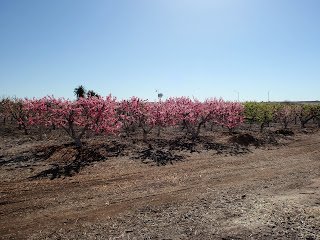I had wanted to add additional fruit trees to the garden. I had a bonanza peach that I had gotten when we first moved into our home. It was a dwarf tree, and it lived on the patio in a pot the first year. I finally decided to plant it into the ground and for nine years we had that dwarf bonanza peach and it was pretty, the flowers were awesome, but the fruit were pale in color, the flesh white-greenish, they were small and they were acrid. The had a slight tart sting to the tongue. So you think 'they are not getting what they need', maybe it is the lack of sun....
They were not picked too early, because you first notice them, ripened, when they are lying on the ground. The tree had a full lush canopy of leaves. The fruit were well hidden. That is why we had the tree so long. It looked so healthy.
Then you hear stories of peaches growing here in Las Vegas that are delicious, then you happen to taste one, and that is it! That dwarf peach has got to go. So I cut it down and dug up the root. I want you to understand what this entailed, so here is a photo of the tree.
As you can see from this photo it stood about 7 feet tall. It seemed like a big decision, and my husband wasn't too happy about it, but it was awkward to say I had a peach tree that you couldn't eat the peaches. I wanted a peach tree where you could eat the peaches, not an ornamental, althought it sure was pretty!
After it was gone, then I drew up a design of the backyard so that I could incorporate more fruit trees into the backyard space.
Then I ordered fruit trees from the local master gardeners fruit tree order they put together in the fall.
In the photo you can see the persimmon in the area in the top center on the right. It grew from two seeds that I had planted from a fruit I had gotten from the orchard when I worked as a master gardener a few years earlier. I am no longer a master gardener. You could consider me a retired master gardener.
Well the two seeds that I had planted had both sprouted and were 3 feet tall. I had to cut one off at the base because they were not able to be transplanted and I couldn't keep two. I researched it and it did say they have a very long tap root, and if you cut the tap root that it will not survive, and as we live in a very rocky location, removing one of them by cutting it off was my only option. Here is a photo of the two persimmons.
So that is what I did. I only have one now and it is going to be interesting to watch it grow and I will have to determine how to manage it because it is very close, as in extremely close to the pomegranate tree.
So with all of this, I waited for the fruit trees that I had ordered to arrive!




























